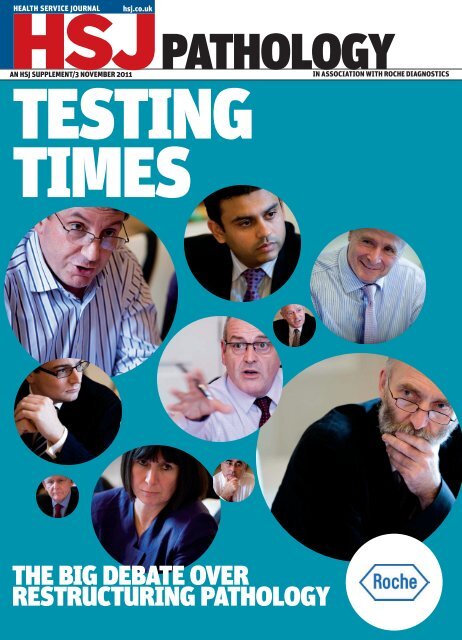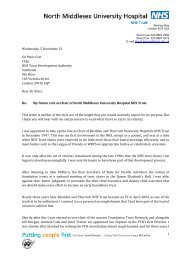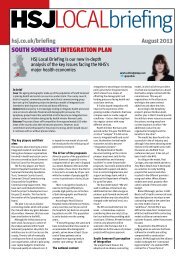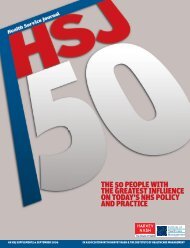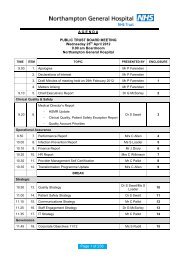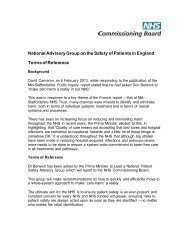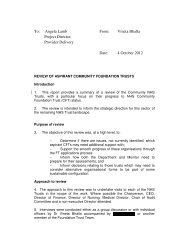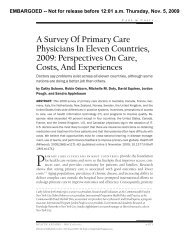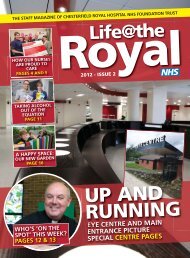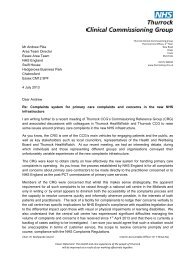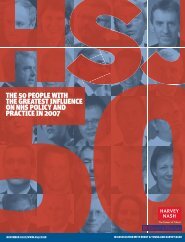HSJ Pathology Supplement - Health Service Journal
HSJ Pathology Supplement - Health Service Journal
HSJ Pathology Supplement - Health Service Journal
- No tags were found...
Create successful ePaper yourself
Turn your PDF publications into a flip-book with our unique Google optimized e-Paper software.
e better?Joining the debate (from left): Michael Thomas,Jill Rodney, Richard Jones, Hemal Desai androundtable chair Mike Sobanja. Below: AdrianWoolmore (left) and Martin Myersbest, with pathology networks linking intothese. PCT clusters had been asked to comeforward with their ideas.Mr Sobanja questioned what the role ofcommissioners would be in this – did itinvolve dictating to providers what theinfrastructure should look like? ProfessorNewland said commissioners wanted to getas cost effective a service as possible.But Professor Peter Furness, president ofthe Royal College of Pathologists, said therewas a more fundamental question: what wasmeant by pathology? In the Carter report ithad been used to describe an end-to-endservice but it had also been used in adifferent, more narrow sense.“It raises questions about whether we aretalking about a single system delivering theend-to-end service,” he said. He pointed outdemand management was part of this asabout 40 per cent of tests were notnecessary; an organisation working on acost per test basis would have no interest inreducing demand. “We have to have asophisticated view of what we arediscussing,” he said.Richard Jones, chief executive of jointventure GSTS <strong>Pathology</strong>, said there weresignificant benefits in consolidating fromthe laboratory processing point of view,allowing the service to cope with five timesthe volume for just twice the cost.“The challenge is how you do that withoutdestroying the relationship with the wholeclinical service,” he said. “I would claim thatGSTS is part of that solution.” His company– a joint venture – is in partnership with twotrusts in London and involved in the end-toendjourney.“There is also the issue of research anddevelopment which is key to the mission ofour partners but at the same time we want torealise some of the savings.”Cherry pickingThe key challenge was how to deliver theseefficiency savings without losing the clinicalservice proposition. He did not believe apure outsourcing solution – a man and a vancollecting samples – would work andfavoured a partnership which would realisebenefits but preserve clinical quality.Dr Martin Myers, clinical director ofpathology at Lancashire Teaching HospitalsFoundation Trust, pointed to the issue offragmentation of services and cherry pickingin direct access services. For example,changes to one element of the service, suchas direct access pathology, might save moneybut could impact on other parts – such aspathology in secondary care. “If we seepathology as a holistic service with primaryand secondary care delivery there has to be adifferent solution without cherry picking,”he said.Professor Newland said in London theywere clear that clinical aspects of care wereparamount. They were creating a three tierapproach with hubs, spokes and specialistservices but had very good provision ofresearch elements and the clinical servicewhich they did not want to disrupt.“We have taken very much on board theclinical importance of what we are doing,”he said.Mr Sobanja pointed out the importance ofeducating trainee medics to use pathologyservices and the impact this could have onother parts of the workforce. “We are gettingmore and more reports of doctors comingout of medical school not trained how to uselaboratory tests or the pathology service,” hesaid. “If that changes, then the picturechanges.”Mr Sobanja said the Carter report hadbeen produced at the end of a phase whichwas about controlled planning but the NHSwas now entering a phase of providerbusiness; it would be for providers to gettogether and plan. A result of this could bethat “one size did not fit all” in terms ofservices: this meant that London could comeup with a different solution from the one forthe rest of the country. Another option wouldbe to let the market determine the shape ofthe service. “What is the predominant driverat the moment?” he asked.Professor Furness said that the marketwilde FRyhsj.co.uk3 November 2011 <strong>Health</strong> <strong>Service</strong> <strong>Journal</strong> supplement 3
oundtable: pathologyHow will we measure quality (from left)? RayPrudo; Peter Furness, who raised concerns overquality indicators; Martin Myers; Jill Rodney andAdrian Newland. Below (from top): Hemal Desaiand Michael Thomaswas going to be important in England butalready there were different models evolving.But he feared that these might evolvewithout people having a sufficientlysophisticated view of what comprises qualityin a pathology service. Having definedpathology as the end-to-end service, howthen was quality defined and measured?“How are you going to know which modelis working best?” he asked. Patientoutcomes are often looked at as measures ofquality but pathology comes at the start ofthe process, which can make it hard to relateto patient outcomes. Professor Furness saidthe Royal College of Pathologists had beenlooking at some key performance indicatorsthat could be used, such as the availability ofexpert advice.“If you have not got the measurementtools in place then you can’t know what thequality is,” he said.Dr Desai said he welcomed what the RCPwas doing. But he pointed out that whatquality was depended on what perspectiveyou had. He questioned whether laboratorybased quality markers were necessarily theright ones.“I completely agree with it being a clinicalservice,” he said. “Having the whole serviceprovided to a whole set of customers in thesame way does not meet the needs of allthose customers.”<strong>Pathology</strong> services in a hospital did nothave to be the same as a pathology service toa community, he said; the demands andrequirements were different.Richard Jones said the key to getting thisright was to give the NHS the financialbenefits from production economics withoutundermining the pre and post analysisadvice from the pathologist. But it wasimportant to get pathologists to work innetworks as well as laboratories. In manydistrict general hospitals, some specialist‘I don’t think we shouldbe blinkered – thatwe can only have a biglaboratory. In 10 years’time we will have adistributed system’pathologists were almost single-handedpractitioners and networks could help them.This could help avoid the position whereclinical staff were raising concerns aboutquality as production was consolidated.Dr Desai said: “For me as a GP, acommissioner, what happens in thelaboratory does not matter as long as I getthat service. I don’t really mind where thepathologist is as long as I can access them.”One service or two?Mr Sobanja posed the question of whetherthe clinical pathology service needed to becommissioned separately from theprocessing part of the service.Mr Jones said in London 50 per cent ofthe work done was direct access and 50 percent was part of the acute care package. “Formost pathology laboratories they do havethat 50/50 split,” he said. “If an acute trustlost 50 per cent of its activity it wouldgrievously undermine the financial viabilityof the rest of the work.”GPs might not be bothered about whathappened to that work but hospitals wouldbe very concerned. “If you lose yourmarginal activities you are left with fixedcosts. There lies the risk for a laboratory thatloses its direct access work.”Institute of Biomedical Science chiefexecutive Jill Rodney said: “I think weshould care what happens in the laboratory.The one thing that we know about the NHSis the degree of variability across variousproviders. If you commission for mediocritythen that it what you will get.”She warned they needed to be cautiousabout a market where providers couldstimulate demand and cost savings whichpeople hoped to squeeze out might notmaterialise.But Dr Desai said he had assumed thatlaboratories were providing a level of servicethat met a minimum standard and, beyondthat, operationally what happened in thelaboratories was “not my concern”.Professor Newland said the clinicalcomponent and the process could not beseparated.“If you pick and choose you end up losingthe staff that provide the service. What youmust not do is load the costs.”Association for Clinical Biochemistrypresident Dr Michael Thomas said pickingand choosing really concerned him. Hepointed out the vast range of services offeredby pathology – from very cheap tests tomuch more expensive and complex ones.But one underpinned the other and as soonas the cheap end was removed it started toundermine the ability of a laboratory toprovide the specialist tests.“Research and development is a key factorwhich needs to be costed into the overallservice of pathology,” he said.Professor Newland said that the Carterreport recognised that 30 per cent of thecosts were interpretation, research anddevelopment, and teaching and trainingcosts. And there was a need to cost thisproperly.Mr Sobanja asked the panel to describewhat pathology services might look like inEngland in 10 years’ time.Professor Furness said there would be4 <strong>Health</strong> <strong>Service</strong> <strong>Journal</strong> supplement 3 November 2011 hsj.co.uk
considerable consolidation of pathology asnormally defined – analysing samples, andproducing numbers. But the delivery of theother bits of the service needed to bedevolved as they involved closer cliniciancontact.“It is potentially tempting to suggest thatwe should commission the analysis andclinical bits separately,” he said.“As soon as you get into morecomplicated tests you need someone whocan span the bedside to the laboratory toensure that things don’t fall between thecracks. The biggest single cause of patientdamage is at the interface.”So how far will consolidation go?Professor Newland said: “I think we will see,in England, 20 to 30 hubs and I think it willbe closer to 20.” In some areas there werenot obvious hubs.“We have to have clinical pathologynetworks as well. You can’t abandon aclinical pathologist in a DGH with a smalllaboratory without proper support.“We have to have movement of staffwithin networks so we can keep them freshand up-to-date with what is going on andpart of the process.”Need for clinical networksMr Jones said it was relatively easy to getcompanies such as Roche to model what aredesigned service might look like – but nota lot of people seemed to have done thethinking around professional relationships.He had discussed this with non teachinghospitals around London and found thatclinicians liked the idea of clinical networks.He was concerned that the production sideof the transformation could run ahead of theclinical side and this could be a quality issue.KPMG associate director AdrianWoolmore said that, where clinicalleadership did not push change andrecognise the quality issues, there tended tobe stalemate, with cost driving change.“Taking 30 per cent out of pathologyservices would impact on people. Thequestion for me is how we get the clinicalleadership to take that decision,” he said.‘Phenomenal’ efficiency increaseProfessor Newland said that in hisorganisation over the past three or four yearsthe workload had increased by 20 per centbut the total budget had dropped by 4 or 5per cent; and they had 70 whole timeequivalent fewer staff through not replacingpeople when they left. This amounted to aphenomenal increase in efficiency within ashort period. Mr Sobanja commented thathe could not think of another part of thehealth service where technology had led toso much restructuring – and yet it was clearthis had not been enough.Dr Myers added: “Part of the problem isthat we see the costs as within pathology butthe costs are within the patient journey.”There was a need to look at how the costsof pathology affected the whole clinicaljourney. “I would say that pathology shouldbe delivered where we want it – if we want itnext to the patient then I think that can bedelivered.“I don’t think we should be blinkered –that we can only have a big laboratory. In 10years’ time we will have a distributedsystem.”Dr Ray Prudo, executive chairman of TheDoctors Laboratory, which offers pathologyservices, drew a comparison with othercountries. “We are 20 years behind what hashappened elsewhere. I spent 15 years inNorth America … what has happenedelsewhere is that you get what you pay for.”For example, pathologist input variedenormously and pathology providers couldbe focused on hospitals, the community orwilde FRyhsj.co.uk3 November 2011 <strong>Health</strong> <strong>Service</strong> <strong>Journal</strong> supplement 5
oundtable: pathologysomewhere in the middle. The need toreduce costs was the driver in many cases, hesaid: in Ontario, the number of laboratorieshad been reduced from dozens to just threeor four.The UK was likely to end up adopting oneof these models and the question then waswho could run them best. “My answer tothat is very simple – whoever can deliver.What we have heard is that pathology is avery complex set of services, it is not oneservice. In pathology we have all thesecomplexities within one organisation.”He said the UK did not have muchexperience with re-engineering. ButProfessor Furness pointed out that theCarter report had said that the UK systemwas one of the most cost-effective in theworld. And Dr Myers asked: “If they havebeen doing it for 20 years then why are theystill the same cost base as us?”Standardised testsBut Dr Prudo said the US system was plural:“In America you see every single model youcan think of. Within that there are somewhich are very successful and some whichare not.”Professor Newland said that the UK hadproved itself on quality but suggested the preand post analysis side was whereperformance was “pretty poor”. “We arepretty bad at getting the specimens to thelaboratory and getting them out – we are aceat looking at the samples,” he said. MrSobanja, however, pointed out there hadbeen some “horror stories” around cytology.Professor Newland said: “There is anirreducible minimum of errors – around 3 to4 per cent. It is the mechanisms we have inplace to ensure they don’t get out – thechecks and so on.”Dr Desai pointed out that simple thingswhich might be assumed to happen – such‘It is cheaper atthe moment to dothe test than to argueabout whether it isnecessary or not. Wehave to change that’as standardised tests and ways ofcommunicating – did not happen acrosspathology services. “There are technicalstandards which you would expect to existwithin pathology,” he said, adding thereshould be a body that set standards.Professor Newland said there had beenprogress on such issues and a meeting wasplanned for the end of October which wouldlook at them. The current system oflaboratory accreditation had served themwell but now needed to change. They wouldlook at ways of using all the informationabout quality from the different perspectivesof people who wanted different things – forexample, the patient and GP.Dr Myers agreed there was a need forstandardisation and the minimising ofvariation. “We have got that wrong inpathology,” he said.Mr Sobanja suggested there was adifference between how you regulated andwhat quality was. He suggested thatregulation by multiple bodies could result infailure, whereas with a single regulatorybody it was obvious where the buck stopped.Professor Newland pointed to the amountof work the National Institute for ClinicalExcellence was doing around diagnostics.“In pathology we have sometimes been ourown worst enemy,” he said, explaining thathe knew of tests done by three differenttrusts which resulted in three differentresults.He suggested that there was value indefining what tests should be done and whatshould not.Dr Desai raised the issue of how intenselylaboratory equipment was used and whethera system that had equipment not being usedfor much of the time could be an efficientmodel.The Carter report suggested thathaematological analysers were only used 25per cent of the time, Professor Newland said.Dr Myers pointed out that UKbenchmarking had shown that in clinicalbiochemistry the cost had gone down inboth absolute and real terms over the past 10years. “If your entire costs have gone downdoes it matter how much redundantequipment there is?” Dr Desai said: “Itmatters to me because it shows that it hasnot reduced enough.”But was it always right to send all “cold”work to a central laboratory? Dr Thomasdoubted it because there would always be aneed to provide some core services within ahospital and that “sweating the assets” onsite might be a cheaper option.What will be done on site?But Professor Newland said that dependedon what equipment there was on site. About20 per cent of work needed to be done onsite, he said. “You fill up your machine timewith some of that work,” he said. “It’s aquestion of how much machinery you haveand how hard you work it.”So what will be the characteristics of asuccessful pathology service as we moveforward? Mr Sobanja suggested that aquality service would be one that knew itscustomers and their needs, and tried to meetthem: “One that could demonstrate that itsquality is as high as it could be. One that6 <strong>Health</strong> <strong>Service</strong> <strong>Journal</strong> supplement 3 November 2011 hsj.co.uk
Keeping up with the science (from left): Adrian Woolmore; Mike Sobanja; and RichardJones, who said pathology services would need to innovate in response to scientificadvances. Below: Peter Furness (top) and Adrian Newlandcould demonstrate that it was operating atan appropriate cost within a tax fundedmodel.”From a taxpayers’ perspective he said:“There is something about demonstratingcosts and, even more, a pathology servicethat is able to demonstrate its value in termsof the difference it makes to outcomes forpatients.”Personalised medicineRichard Jones said it was necessary toinclude something on innovation to the listof characteristics and highlighted the impactof molecular diagnostics, which opened upopportunities for pathology services thatorganisations needed to grasp. “We need totake advantage of scientific and medicaladvances,” he said.Professor Newland added thatpersonalised medicine would be important.An example of this was where testing coulddetermine which patients would benefitfrom new drugs so that money was notwasted treating those who would notrespond. “The problem we have inlaboratories is funding the introduction oftests that enable us to do that – to identifythe patients who can benefit from particulardrugs,” he said.Dr Prudo said there was a need to havepathology support for individuals. “We don’thave people trained in this kind of activity.It’s very doctor intensive.” Pathologistsmight have to pull together lots of differentinformation “We are going to require moreand more medical expertise to identify this.”Professor Furness called for decisionmakingbodies to say what should andshould not be used.“We can’t reasonably expect every singlelocal laboratory to be physically able to dothat job. It has to be more centralised. NICEis the obvious candidate for most of the stuffbut it is getting more complex.”Advice could extend to what is and isn’tworthwhile using in particularcircumstances. This could offer a way ofrelating the cost of tests to budgets – as itwould be clear that savings were made bynot doing things the patient would notbenefit from.“It is cheaper at the moment to do the testthan [to] argue about whether it is necessaryor not. We have to change that,” he addedProfessor Newland mentioned patientaccess to results, especially as where tests aredone diversifies – “the patient has to be incharge of that”.But while there was acknowledgementthat a diversity of providers is likely to beinvolved, Mr Jones pointed out some of theissues that held back the private sector. Hesaid: “There are issues around tariff andtransaction management, aroundprocurement rules and competition, and alsoaround TUPE and the impact on theworkforce of moving people around. Theyare massive issues preventing the marketplaying the part it can in this.”Jill Rodney said that people were vital tomaking change happen and they had notbeen talked about; clinical leadership wascrucial in all of this.Dr Prudo said there had been a lot ofdiscussion around cost but not what thebenchmarks for costs were. He highlightedthe very different costs between hospitals.Bringing the debate to an end, MrSobanja drew a series of key points out ofthe wide-ranging discussion. Theseincluded:l What do we mean by pathology? Was it anend-to-end service or simply a diagnostictesting service?l Variation was a critical issue. Reducingunwarranted variation is one of the mostproductive things we can do in the NHS, hesaid.l There is no “one size fits all” system.l Key performance indicators would beimportant for the service as wouldregulation/accreditation.l There was a distinction between the dataprocessing side of pathology services and thepathologist service – which raised questionsabout how they should be commissionedand whether different commissioningmechanisms were needed for these differentparts of the service.l 20-30 hubs for pathology services hadbeen proposed as a model with possibly amore “distributed” focus.l The role of the private sector would beimportant – “whoever can delivereffectively”.l Issues around workforce needs in thisnew world should not be forgotten. lwilde FRyhsj.co.uk3 November 2011 <strong>Health</strong> <strong>Service</strong> <strong>Journal</strong> supplement 7
Enabling improved patient care for 15 yearsSetting the standards in immunochemistry30,000 Elecsys systems producedThis tremendous success story started in the summer of 1996 with the launch of the Elecsys ® 2010, the firstRoche Diagnostics system using Electrochemiluminescence (ECL) technology. Since then, our Elecsys menu hasgrown to over 85 applications, including our latest assays:• Elecsys HE4Supporting improvements in ovarian cancerdiagnosis and therapy in women with pelvicmass• Elecsys Vitamin D totalEnabling better patient care with results youcan trust• Elecsys HIV combi PTEnhanced sensitivity for early detection of HIVinfection15 yearsECLTechnology• Elecsys hGHExcellent precision for reliable diagnosis• Elecsys HBsAg II quantitativeThe next generation HBsAg quantification test- optimized for clinical decision makingThese applications are used on over 20,000 active systems worldwide, providing a total test volume of 1 Billiontests per year – or 30 patient results per second.It’s a track record we are proud of.Roche Diagnostics Limited, Charles Avenue, Burgess Hill, West Sussex RH15 9RY01444 256000 (calls to this number may be recorded)www.roche-diagnostics.co.ukRegistration number 571546


